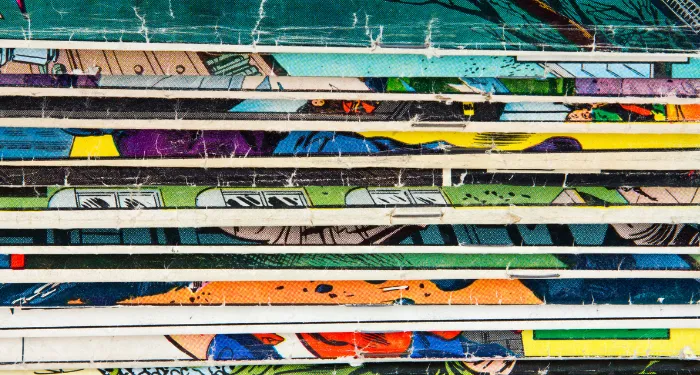
The History of the Underground Comix Movement
Censorship has long plagued the history of publishing. As long as books have been around, they have been banned and people have attempted to restrict what others can write. Comics and graphic novels are no exception.
When you think of comics of the 1950s and 1960s, you probably think of wholesome Superman comics and early Captain America. However, this time period saw the rise of “Underground Comix”. This movement was very much a product of its time. It was a counter-cultural movement involving the publication of small press comics. Most of these comics were either rude or satirical. This was a time in America when the hippies were at their height, and so was the controversy surrounding the Vietnam War.
Pre–Underground Comix
There are several cousins of Underground Comix that arrived on the scene first. One of the earliest examples was Tijuana Bibles. Tijuana Bibles were eight-page dirty comic books, often featuring popular cartoon characters. These comics were illegally distributed throughout the 1930s–50s. Most of the artists remain unknown.
Zines are other underground publications also dating back as early as the 1930s. They rose to prominence a little later than Underground Comix, taking the punk scene by storm in the 1970s and ’80s. That said, they have a great deal in common with illegal Underground Comix.
The most famous cousin is Mad Magazine (1952–2018), which originally started out as a series of comics. Through coincidence, Mad avoided upcoming censorship laws by transitioning from exclusively comics to slick magazines. Mad’s net of influence was cast far and wide during its 67 year run. It style and sense of humour inspired many comic artists in the Underground Comix movement.
No Fun Allowed: The Comics Code Authority
In 1954, a new organization brought the hammer of censorship down onto American comics. Following the Motion Picture Production Code, which was made to self-censor films, the Comics Code Authority emerged in all its horrible glory.
Dr. Fredric Wertham was also largely responsible for the Code. His book, Seduction of the Innocent, correlated juvenile delinquency with violence and sex in comics. Parents rallied around this and were more than happy to burn these books for the “sake of their children”.
And so, the Comics Code was born. If the Code did not approve your comic, it would not be stocked in stores. There were 41 restrictions, including the obvious: no sex, no drugs, no cursing. Then there were more specific moralistic issues, such as no words such as “terror” in the titles and that cops could never be portrayed as bad guys.
The Rebellion of Underground Comix
As the Code clasped its cold dead hands around mainstream comics, artists were left with two choices. They could submit, and sanitize their work beyond all recognition. Or, they could resist. This was what kickstarted the Underground Comix movement.
Big comic companies such as DC and Marvel had to follow nitpicking guidelines. Meanwhile, individual artists in Underground Comix were putting out wild stuff. Underground Comix were gritty, dirty, raunchy, and controversial. Some prolific artists of this movement include R. Crumb, Art Spiegelman, S. Clay Wilson, Spain Rodriguez, and Gilbert Shelton. These artists willingly went against the grain to make their work.
Some of the work of the Underground Comix movement has been criticized for being misogynistic, glorifying of violence, or socially irresponsible. That is definitely true in some cases. However, the Code also prohibited discussion of sexuality, especially LGBTQ+ matters, and many other issues. Artists were able to find their voices in this movement, and speak on issues that mattered.
It is important to remember that these artists could not do it alone. Many had the support of local comics shops. Print Mint, Last Gasp, S.F. Comic Book Company, Kitchen Sink, Apex Novelties, and many more organizations helped to keep this movement alive. They faced the threat of prosecution from the Comics Code Authority for keeping these books on their shelves. Nevertheless, they continued to support these artists.
Wimmin’s Comix
The Underground Comix movement was very masculine. In response, an all-women comic collection called “It Ain’t Me, Babe” was published in 1970. The Wimmin’s Comix movement was formed not long after that. Some of these artists include Terry Richards, Lee Marrs, Trina Robbins, Pat Moodian, Aline Kominsky, Michele Brand, Shelby Sampson, Karen Marie Haskell, and Janet Wolfe Stanley. Together, they made the first ongoing comic series made entirely by women.
Wimmin’s Comix was only the first of its kind. Tits ‘n Clits Comix and Twisted Sisters followed soon after. In the 1970s, Anarchy comics began to rise, but Underground Comix was drawing to a close.
The End of Underground Comix
Artists Art Speigelman and Bill Griffith founded Arcade in 1975. This comic featured many prominent artists from the movement, and it bookended the end of the first wave of Underground Comix.
The Comics Code lessened its hold over the years as the moral panic died down. More and more companies willingly broke the Code, no longer fearing repercussions. In 2011, DC and Archie were the last to stop following the Code. This ended its more than 50 year reign.
Underground press of different sorts is alive and well today. There are always going to be people rebelling against the norm. There are always going to be people who want to make comics.











